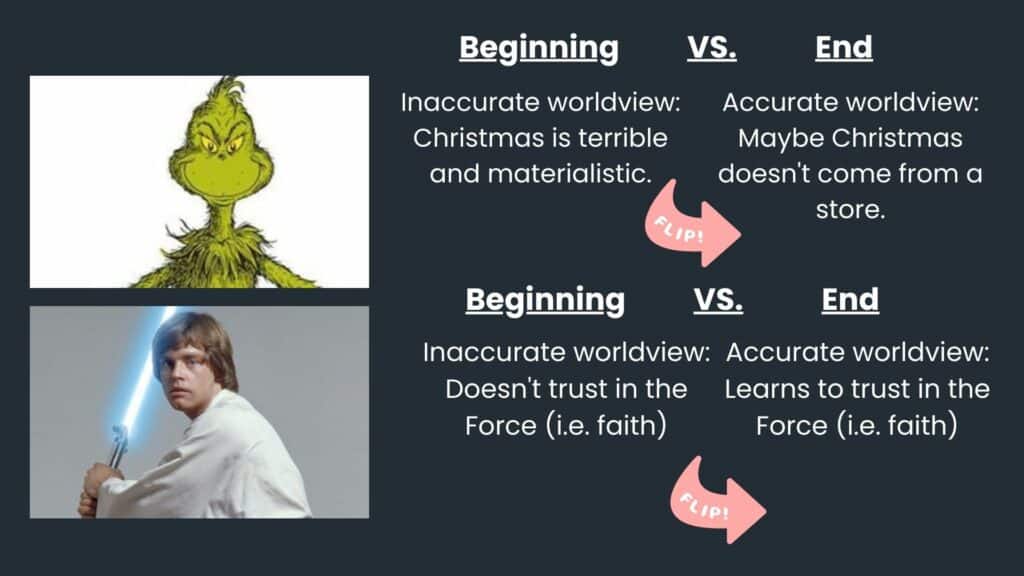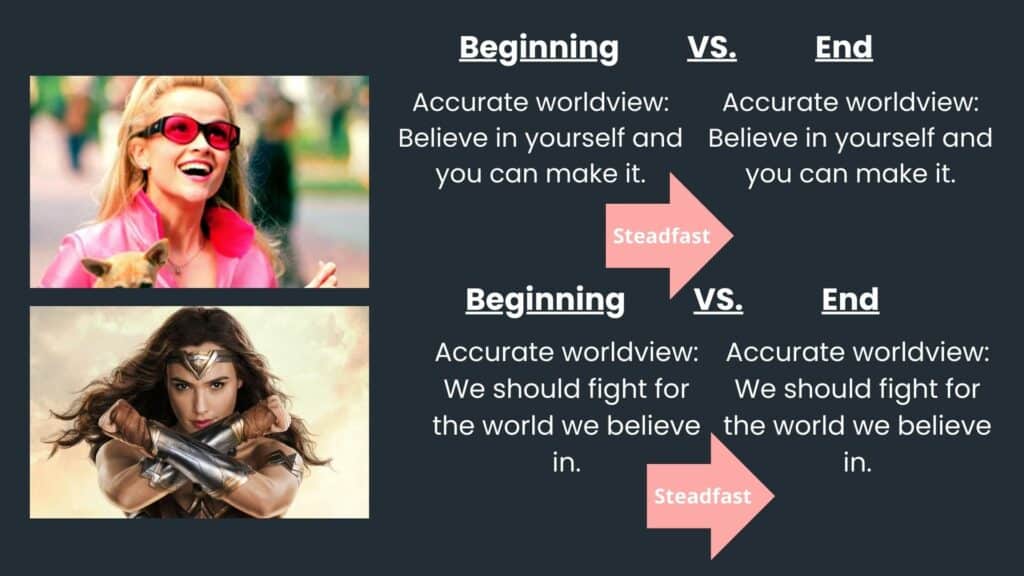In a steadfast arc, the character holds true to who he was in the beginning.
Often when we think of characters arcs, we think of characters changing for the better: Scrooge giving up his miserly ways to show charity toward his follow men, Luke Skywalker choosing to trust in faith (the Force) to successfully hit the Death Star, or Harry Potter learning that love is the most powerful magic in the world.
Most writers write positive change arcs. And most writers are taught to write positive change arcs. And most approaches to structure, such as the Hero’s Journey and Save the Cat, will have you structure a positive change arc story.
But that is only one type of arc.
Yes, a character can grow by changing.
But a character can also grow by increasing his resolve to remain true to who he was in the beginning. He can become more of what he was initially.
Change Arcs vs. Steadfast Arcs
In a change arc, simplistically speaking, the character does a flip from the beginning of the story, to the end of the story. In the beginning of The Greatest Showman, P. T. Barnum believes he needs everyone to accept him, an inaccurate worldview, but by the end of the story, he learns he only needs to be accepted by a few loved ones.


A steadfast arc is different. Instead of doing a flip in worldviews, the character ultimately holds steadfast to who he was in the beginning. In The X-Files, Fox Mulder begins the story believing the truth is out there, and that he needs to find and uncover it. Despite being tested and tempted, he ultimately holds true to what he believes in the beginning, at the end, even risking the death penalty to uphold it.
Mulder doesn’t flip in his beliefs; he grows in his resolve of them.
Likewise, in The Hunger Games, Katniss starts the story believing we should be willing to sacrifice ourselves to save others, as shown by the fact she volunteers in her sister’s place. Although she is tested and tempted by the Games, and even wavers in parts, at the end, she ultimately upholds that worldview, by risking death to try to save Peeta.
And in Legally Blonde, Elle Woods thinks that if you believe in yourself, you can make it (whether “it” be law school or something else), and she ultimately proves that true to those around her in the end.


This isn’t to say that Mulder, Katniss, and Elle, don’t learn or grow in any other ways, but just that in their primary arcs—the arc most closely connected to theme—who they are and what they believe initially, remains intact.
3 Helps for Steadfast Protagonists
A steadfast arc, also known as a flat arc, is perhaps the most misunderstood arc. And if you try to apply positive change arc advice to one, at best you’ll accidentally turn your protagonist into a positive change arc protagonist, or at worst you’ll spend years feeling like you can’t write your way out of a paper bag without knowing why.
Change arc advice doesn’t work for steadfast characters.
So, let’s go over some principles to help you get started, should you want to write a steadfast story.
#1. Swap Arcs: Influenced to Influencer
I like to think of steadfast protagonists as the “lefties” of storytelling. Their stories usually have the same pieces, just reversed.
Most change arc stories will feature a steadfast supporting character—this is usually someone the protagonist is in an important relationship with, like a best friend, parent, or mentor. This person helps facilitate the protagonist’s transformation, usually by guiding him to the accurate worldview (the lesson the character needs to learn).

In a steadfast story, this is swapped.

We reorient the story so the influencer is the protagonist. She is helping others change. Commonly, one supporting character will be highlighted. Mulder eventually helps Scully to change. Elle coaxes Paulette to believe in herself. Moana convinces Maui that who he is, isn’t his hook, his appearances, or his good deeds—it’s who he is on the inside.
Often the steadfast protagonist not only helps one person change, but a whole society. Katniss’s stunt with the berries, influences the Districts. And not only does Moana help Maui, but all her people, to remember who they are, as she leads them to become sailors once again.
Typically, the steadfast protagonist facilitates the transformation of others.
#2. Challenge instead of Change
In a change arc story, the obstacles and conflicts are pushing the protagonist through a transformation. He can’t succeed if he doesn’t leave his old self behind to become someone new. He must overcome his inaccurate worldview, and learn what he needs to learn.
In a steadfast story, the obstacles and conflicts are challenging the protagonist, pressuring her to give up. She can’t succeed if she leaves her old self behind; she needs to stay true to who she is. But the antagonist, and perhaps the whole world, are telling her she’s wrong. She must find it within herself to hold fast to her initial beliefs.
In a steadfast story, outside forces try to convince the protagonist she’s wrong and get her to abandon her worldview. It’s Smoking Man and the government insisting to Mulder that the truth needs to be covered up. It’s the Capitol showing we should sacrifice others to benefit ourselves, and pressuring Katniss in the Games to do the same. And it’s everyone Moana runs into who tells her that identity comes from something outside of yourself—it comes from the island, it comes from what’s “shiny,” it comes from how others perceive you.
The inaccurate worldview, comes from outside the character.

As a writer, you want to throw obstacles at the steadfast protagonist that will test his resolve and tempt him to go astray. Think of the story of Job, where the devil throws out destruction, death, and illness to try to get Job to abandon his faith, but in the end, Job upholds that faith.
If you want to create a steadfast story with a powerful internal journey, think of what it would take to get your protagonist to doubt her beliefs and consider going astray. Then put her to the test.
#3. The Backstory Explains the Belief
In most stories, the protagonist’s backstory will explain why he starts with his initial beliefs. In a change arc, this backstory (sometimes called a “ghost”) will reveal why the protagonist has an inaccurate worldview. Why does P. T. Barnum need the world to accept him? Because when he was a child, he was poor, and society and Charity’s father, didn’t accept him. Why does Harry need to learn love is the most powerful force in the world? Because as a baby he was dropped off on the doorstep of his abusive aunt and uncle’s, and for ten years they’ve shown him hate is the most powerful force in his world.

In a steadfast arc, the backstory will reveal why the protagonist has an accurate worldview and why the protagonist believes this worldview so powerfully. Why is Mulder so driven to find and uncover the truth? Because when he was a child, his sister was abducted and the government covered it up. Why is sacrificing for others important to Katniss? Because when she was literally starving to death, Peeta risked abuse to “accidentally” burn the bread, so he could give some to Katniss.

What converted your steadfast protagonist to his powerful beliefs? That’s the part of his backstory you should probably highlight most.
In Closing
This is just an introduction to the steadfast protagonist. And while this article focuses on the positive version, it is also possible to write a negative version, where the character remains the same from the beginning, and is worse off for it.
While a comprehensive explanation of steadfast protagonists is beyond the scope of this post, with these foundational principles, you will be well equipped to begin writing a steadfast journey.
Looking for a storytelling approach that works for more than just positive change arc protagonists? Check out The Triarchy Method of Story—it will work with any type of character arc, including steadfast protagonists. Registration is open and classes begin Jan. 9th, 2024.
About September C. Fawkes:
Sometimes September C. Fawkes scares people with her enthusiasm for writing. She has worked in the fiction-writing industry for over ten years and has edited for both award-winning and best-selling authors, as well as beginning writers. She runs a writing tip blog at SeptemberCFawkes.com and offers an online writing course, The Triarchy Method of Story. When not editing and instructing, she’s penning her own stories. Some may say she needs to get a social life. It’d be easier if her fictional one wasn’t so interesting.
If you would like to delve deeper into the steadfast protagonist, you can find more of her articles on the topic here.








